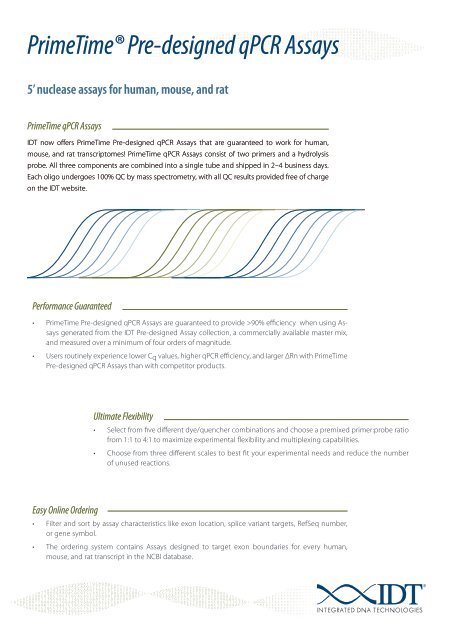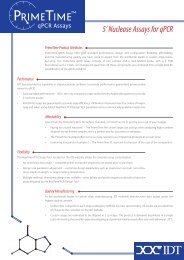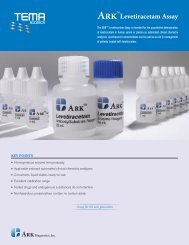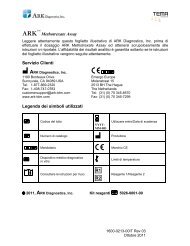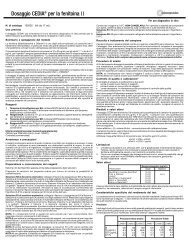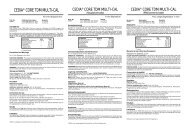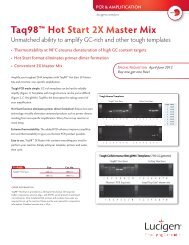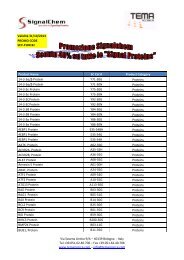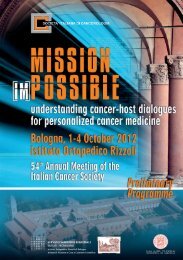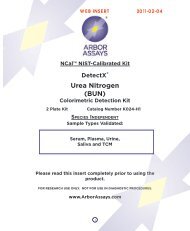PrimeTime® Pre-designed qPCR Assays - Tema Ricerca
PrimeTime® Pre-designed qPCR Assays - Tema Ricerca
PrimeTime® Pre-designed qPCR Assays - Tema Ricerca
Create successful ePaper yourself
Turn your PDF publications into a flip-book with our unique Google optimized e-Paper software.
<strong>PrimeTime®</strong> <strong>Pre</strong>-<strong>designed</strong> <strong>qPCR</strong> <strong>Assays</strong><br />
5’ nuclease assays for human, mouse, and rat<br />
PrimeTime <strong>qPCR</strong> <strong>Assays</strong><br />
IDT now offers PrimeTime <strong>Pre</strong>-<strong>designed</strong> <strong>qPCR</strong> <strong>Assays</strong> that are guaranteed to work for human,<br />
mouse, and rat transcriptomes! PrimeTime <strong>qPCR</strong> <strong>Assays</strong> consist of two primers and a hydrolysis<br />
probe. All three components are combined into a single tube and shipped in 2–4 business days.<br />
Each oligo undergoes 100% QC by mass spectrometry, with all QC results provided free of charge<br />
on the IDT website.<br />
Performance Guaranteed<br />
• PrimeTime <strong>Pre</strong>-<strong>designed</strong> <strong>qPCR</strong> <strong>Assays</strong> are guaranteed to provide >90% efficiency when using <strong>Assays</strong><br />
generated from the IDT <strong>Pre</strong>-<strong>designed</strong> Assay collection, a commercially available master mix,<br />
and measured over a minimum of four orders of magnitude.<br />
• Users routinely experience lower Cq values, higher <strong>qPCR</strong> efficiency, and larger ΔRn with PrimeTime<br />
<strong>Pre</strong>-<strong>designed</strong> <strong>qPCR</strong> <strong>Assays</strong> than with competitor products.<br />
Ultimate Flexibility<br />
• Select from five different dye/quencher combinations and choose a premixed primer:probe ratio<br />
from 1:1 to 4:1 to maximize experimental flexibility and multiplexing capabilities.<br />
• Choose from three different scales to best fit your experimental needs and reduce the number<br />
of unused reactions.<br />
Easy Online Ordering<br />
• Filter and sort by assay characteristics like exon location, splice variant targets, RefSeq number,<br />
or gene symbol.<br />
• The ordering system contains <strong>Assays</strong> <strong>designed</strong> to target exon boundaries for every human,<br />
mouse, and rat transcript in the NCBI database.
<strong>PrimeTime®</strong> <strong>Pre</strong>-<strong>designed</strong> <strong>qPCR</strong> <strong>Assays</strong><br />
Design Process<br />
IDT’s design engine incorporates many parameters to produce the best possible PrimeTime <strong>Pre</strong><strong>designed</strong><br />
<strong>qPCR</strong> Assay. The design process uses the most current, clean, and complete target sequence<br />
information and stresses accurate Tm prediction and protection against off-target amplification.<br />
The process includes a wealth of additional secondary design considerations and design<br />
scoring criteria focused on isolating the best performance potential for a specific target design.<br />
Current target sequence information<br />
Access the most current<br />
sequence data available<br />
• The IDT design engine runs against the cleanest possible target data that<br />
include up-to-date SNP and intron/exon junction locations.<br />
• The design libraries are continually refreshed as new sequence data<br />
become available.<br />
Melting temperature (Tm)<br />
Design assays with<br />
accurate Tm for primers<br />
and probes<br />
• Accurate prediction of Tm is essential for precise PCR performance.<br />
• The assay design engine incorporates the most currently available Tm<br />
prediction algorithms and nearest-neighbor parameter sets.<br />
• IDT continues innovative DNA thermodynamics research and integrates<br />
those improvements into its calculation and oligonucleotide design tools.<br />
Cross reaction and off-target amplification prevention<br />
<strong>Pre</strong>vent cross reaction<br />
and off-target<br />
amplification, mask<br />
SNPs<br />
• Proprietary assay design engine algorithms and BLAST alignments check<br />
the target sequence to protect against cross reaction and off-target<br />
amplification.<br />
• The algorithms reduce potential off-target amplicon formation, as well<br />
as individual element non-specificity that can compromise efficiency by<br />
consuming assay components through off-target interactions.<br />
• The Assay design engine ensures that primers or probes are not placed on<br />
SNP locations.<br />
Score remaining<br />
assays and publish<br />
to web<br />
Scoring and Publishing<br />
The main assay design engine algorithm is tuned to aggressively “over-design”.<br />
-<br />
This produces dozens of possible assay options for each target which are then<br />
carefully weighed for selection of those with the best overall performance<br />
and reliability characteristics. These selection criteria include examination of<br />
characteristics such as poly runs, short sequence repeats, and hetero-dimer and<br />
homo-dimer folding energies.
Validation of the Design Engine<br />
To validate the design parameters, IDT tested 150 randomly selected PrimeTime <strong>Pre</strong>-<strong>designed</strong><br />
<strong>qPCR</strong> <strong>Assays</strong>. Each assay was analyzed with a 5 log dilution series from 50 ng to 5 pg UHR cDNA.<br />
Efficiency measurements were calculated from the standard curve. All experiments were performed<br />
on the ABI 7900HT Fast Real-Time PCR System with the Applied Biosystems Gene Expression<br />
Master Mix.<br />
Result Highlights<br />
• More than 99% of the <strong>Assays</strong> tested exhibited >90% efficiency.<br />
• 100% of the <strong>Assays</strong> had R 2 values >0.99.<br />
• The mean efficiency of all <strong>Assays</strong> was 94.5%.<br />
• Over 2/3 of all <strong>Assays</strong> had >95% efficiency.<br />
30%<br />
Distribution of Assay Efficiency<br />
25%<br />
Figure 1. IDT Assay Selection Engine Generates<br />
Highly Efficient <strong>qPCR</strong> <strong>Assays</strong>. 150 <strong>Assays</strong> were<br />
selected randomly and analyzed with a 5-fold<br />
standard curve of UHR cDNA. Each reaction<br />
was tested with 500 nM of each primer and 250<br />
nM FAM/ZEN/IBFQ probe with the Applied Biosystems<br />
TaqMan® Gene Expression Master Mix.<br />
The reactions were run on the ABI 7900HT Fast<br />
Real-Time PCR System with the following PCR<br />
cycling conditions: 2 min. 50°C; 10 min. 95°C;<br />
45 x (15 sec. 95°C, 1 min. 60°C).<br />
Frequency<br />
20%<br />
15%<br />
10%<br />
5%<br />
0%<br />
86 - 87<br />
87 - 88<br />
88 - 89<br />
89 - 90<br />
90 - 91<br />
91 - 92<br />
92 - 93<br />
93 - 94<br />
94 - 95<br />
95 - 96<br />
96 - 97<br />
97 - 98<br />
98 - 99<br />
99 - 100<br />
100 - 101<br />
101 - 102<br />
102 - 103<br />
103 - 104<br />
Calculated Efficiency (%)<br />
<strong>Pre</strong>-<strong>designed</strong> <strong>Assays</strong> Work With All Master Mixes Tested<br />
16 different PrimeTime <strong>Pre</strong>-<strong>designed</strong> <strong>qPCR</strong> <strong>Assays</strong> were tested with 6 commercially available master mixes. A miniGene<br />
plasmid was used as a template and diluted over 6 logs to calculate efficiency. The reactions were all run on the ABI<br />
7900HT instrument at the recommended concentration and cycling conditions for each master mix. All <strong>Assays</strong> exhibited<br />
greater than 97% efficiency with a 100% success rate.<br />
Commercial Master Mix Mean Efficiency (%) Percent Success<br />
Agilent Brilliant III Ultra Fast QPCR 96.89 100<br />
Applied Biosystems TaqMan® Gene Expression 97.96 100<br />
Invitrogen SuperMix 97.68 100<br />
Qiagen QuantiTect® Probe PCR Kit 97.31 100<br />
BioRad iTaq Supermix with ROX 100.52 100<br />
BioSciences PerfeCTa <strong>qPCR</strong> 97.64 100
<strong>PrimeTime®</strong> <strong>Pre</strong>-<strong>designed</strong> <strong>Assays</strong> Outperform Competitor Products<br />
Performance Highlights<br />
• Improved Results for Fast Cycling – With PrimeTime <strong>Pre</strong>-<strong>designed</strong> <strong>qPCR</strong> <strong>Assays</strong> and Agilent’s Brilliant III<br />
Master Mix, you no longer have to sacrifice performance for speed.<br />
• Increased Sensitivity – On average, PrimeTime <strong>Pre</strong>-<strong>designed</strong> <strong>qPCR</strong> <strong>Assays</strong> were nearly one full Cq lower<br />
and had endpoint signals more than 30% greater than the competition. (Figures 2 and 3).<br />
• Higher <strong>qPCR</strong> Efficiency – When compared to Competitor A, not only did PrimeTime <strong>Pre</strong>-<strong>designed</strong> <strong>Assays</strong><br />
have a higher average efficiency but the distribution of calculated efficiencies was also greatly<br />
reduced. (Figure 4).<br />
PrimeTime <strong>Pre</strong>-<strong>designed</strong> <strong>Assays</strong> Excel with Fast-Cycling Protocols<br />
Fast cycling allows for higher throughput and faster access to results. Unfortunately, researchers<br />
often have to sacrifice performance for speed. 6 PrimeTime <strong>Pre</strong>-<strong>designed</strong> <strong>qPCR</strong> <strong>Assays</strong> were tested<br />
using the Agilent Brilliant III Ultra Fast QPCR Master Mix, which allows run times as short as 45 minutes.<br />
These results were compared to 6 matched, inventoried assays from Competitor A.<br />
• No sacrifice in efficiency. All PrimeTime <strong>Assays</strong> maintained efficiencies between 90–100%.<br />
2 of the 6 Competitor A assays had efficiency values
Increased Sensitivity<br />
25 assays from Competitor A were compared to an equal number of IDT’s PrimeTime <strong>Pre</strong>-<strong>designed</strong><br />
<strong>qPCR</strong> <strong>Assays</strong>. The Competitor A assays consisted of 15 inventoried pre-<strong>designed</strong> assays<br />
and 10 made-to-order pre-<strong>designed</strong> assays. To ensure an accurate comparison was made, the<br />
PrimeTime <strong>Assays</strong> and Competitor A assays were selected to span the same exon boundary of<br />
each gene. The reactions were run with the Applied Biosystems Gene Expression Master Mix and<br />
identical thresholds were set for all runs (Figures 3 and 4).<br />
Rn (FAM/ROX)<br />
6<br />
5<br />
4<br />
3<br />
2<br />
1<br />
Comparison of Assay Performance with WDR3 (NM_006784)<br />
PrimeTime <strong>Assays</strong><br />
Competitor A<br />
Figure 3. PrimeTime <strong>Assays</strong> Are More Sensitive<br />
than Competitor A <strong>Assays</strong>. PrimeTime <strong>Pre</strong>-<strong>designed</strong><br />
<strong>qPCR</strong> <strong>Assays</strong> were compared to equivalent<br />
Competitor A assays using 5-fold dilutions<br />
of cDNA template and the Applied Biosystems<br />
TaqMan® Gene Expression Master Mix. The reactions<br />
were run on the ABI 7900HT Fast Real-<br />
Time PCR System with the following PCR cycling<br />
conditions: 2 min. 50°C; 10 min. 95°C; 45 x<br />
(15 sec. 95°C, 1 min. 60°C). Identical thresholds<br />
were set for all runs for comparison across assays.<br />
A comparison of the Competitor A WDR3<br />
(NM_006784) assay and the equivalent IDT PrimeTime<br />
<strong>Pre</strong>-<strong>designed</strong> <strong>qPCR</strong> Assay is shown.<br />
0<br />
1 2 3 4 5 6 7 8 9 10 11 12 13 14 15 16 17 18 19 20 21 22 23 24 25 26 27 28 29 30 31 32 33 34 35 36 37 38 39 40 41 42 43 44 45<br />
Cycle Number<br />
Mean Cq Value<br />
30<br />
25<br />
20<br />
15<br />
10<br />
5<br />
0<br />
NM_000362<br />
NM_003105<br />
NM_001855<br />
NM_003922<br />
NM_004308<br />
NM_004343<br />
NM_005188<br />
NM_005911<br />
NM_006325<br />
NM_006784<br />
Comparison of Mean Cq Value<br />
NM_014155<br />
NM_014367<br />
NM_007024<br />
NM_006500<br />
NM_000671<br />
NM_003596<br />
NM_005385<br />
Gene RefSeq Accession Number<br />
NM_005768<br />
NM_001182<br />
NM_006782<br />
NM_002581<br />
NM_014630<br />
NM_014742<br />
NM_012204<br />
NM_014109<br />
PrimeTime<br />
Competitor A<br />
Figure 4. PrimeTime <strong>Pre</strong>-<strong>designed</strong> <strong>qPCR</strong> <strong>Assays</strong><br />
Have Consistently Lower C q Values for the<br />
Same Target. PrimeTime <strong>Pre</strong>-<strong>designed</strong> <strong>qPCR</strong><br />
<strong>Assays</strong> were compared to equivalent Competitor<br />
A assays using 5-fold dilutions of UHR cDNA<br />
and the Applied Biosystems TaqMan® Gene<br />
Expression Master Mix. The reactions were run<br />
on the ABI 7900HT Fast Real-Time PCR System<br />
with the following PCR cycling conditions: 2<br />
min. 50°C; 10 min. 95°C; 45 x (15 sec. 95°C, 1<br />
min. 60°C). Identical thresholds were set for all<br />
runs for comparison across assays. The mean<br />
C q values from the 50 ng dilution of UHR cDNA<br />
are shown.<br />
*Successful assays were considered to be those<br />
that demonstrated >90% efficiency when measured<br />
over 5 logs with R 2 values >0.99.<br />
Higher <strong>qPCR</strong> Efficiency<br />
<strong>qPCR</strong> efficiency was measured using a comparison of 25 Competitor A and IDT assays for sensitivity<br />
(Figure 5). Again, the PrimeTime <strong>Pre</strong>-<strong>designed</strong> <strong>qPCR</strong> <strong>Assays</strong> have a higher average <strong>qPCR</strong><br />
efficiency than Competitor A assays. In addition, the overall distribution of <strong>qPCR</strong> efficiency was<br />
narrower and higher than that for Competitor A assays.<br />
Figure 5. PrimeTime <strong>Pre</strong>-<strong>designed</strong> <strong>qPCR</strong> <strong>Assays</strong><br />
Have Higher <strong>qPCR</strong> Efficiency and a Smaller<br />
Distribution Range than Competitor A <strong>Assays</strong>.<br />
PrimeTime <strong>qPCR</strong> <strong>Assays</strong> were compared<br />
to matched Competitor A assays using 5-fold<br />
dilutions of cDNA and the Applied Biosystems<br />
TaqMan® Gene Expression Master Mix. The reactions<br />
were run on the ABI 7900HT Fast Real-<br />
Time PCR System with the following PCR cycling<br />
conditions: 2 min. 50°C; 10 min. 95°C; 45 x<br />
(15 sec. 95°C, 1 min. 60°C). Identical thresholds<br />
were set for all runs for comparison across assays.<br />
Frequency<br />
14<br />
12<br />
10<br />
8<br />
6<br />
4<br />
Comparison of <strong>qPCR</strong> Efficiency<br />
PrimeTime<br />
Competitor A<br />
2<br />
0<br />
88 - 90 90 - 92 92 - 94 94 - 96 96 - 98 98 - 100<br />
<strong>qPCR</strong> Efficiency (%)
Ordering <strong>PrimeTime®</strong> <strong>Pre</strong>-<strong>designed</strong> <strong>Assays</strong><br />
1. Enter the gene name, RefSeq number, or Assay ID.<br />
2. Select the species from mouse, human, or rat.<br />
3. Click on Submit.<br />
4. To sort the results, drag the column that you would like to sort by to the top. Drag more than<br />
one column to the top to further refine the search.<br />
5. Select the Assay you would like to order.<br />
6. Click on Customize to select the size (Mini, Standard, or XL), the dye-quencher combination,<br />
and the primer-to-probe ratio.<br />
7. Click Add To Order or Add And Checkout button.<br />
A<br />
B<br />
D<br />
C<br />
Enhanced Selection Features<br />
A. Group by symbol, species, or splice variant by dragging the column title to the indicated space.<br />
B. Filter by species, gene symbol, or splice variant.<br />
C. Sort results by recommended <strong>Assays</strong>. When this is selected, the first Assay in the list will be the highest<br />
ranked and most recommended based on IDT scoring parameters.<br />
D. View RefSeq numbers detected for each Assay design<br />
<strong>PrimeTime®</strong> products are licensed by Applied Biosystems for use in the 5’ Nuclease Assay for non-commercial research purposes only. A license to perform the patented 5’ Nuclease Process for<br />
research is obtained by the purchase of (i) both Licensed Probe and Authorized 5’ Nuclease Core Kit, (ii) a Licensed 5’ Nuclease Kit, or (iii) license rights from Applied Biosystems. This product<br />
contains Licensed Probe. Use of this product is covered by one or more of the following US patents and corresponding patent claims outside the US: 5,538,848, 5,723,591, 5,876,930, 6,030,787,<br />
6,258,569, and 5,804,375 (claims 1-12 only). The purchase of this product includes a limited, non-transferable immunity from suit under the foregoing patent claims for using only this amount<br />
of product for the purchaser’s own internal research. The right to use this product in the 5’ Nuclease Process under the applicable claims of US Patents Nos. 5,210,015 and 5,487,972, and corresponding<br />
patent claims outside the United States, can be obtained through purchase of an Authorized 5’ Nuclease Core Kit. Certain <strong>PrimeTime®</strong> <strong>Assays</strong> may contain one or more proprietary<br />
dyes that are sold subject to separate limited licenses. Cy, is a registered trademark of GE HealthCare, and when applicable, the purchaser obtains a limited non-exclusive sublicense under<br />
U.S Patent Nos. 5 556 959 and 5 808 044 and foreign equivalent patents and other foreign and U.S counterpart applications to use the Product to perform research. NO OTHER LICENSE IS<br />
GRANTED EXPRESSLY, IMPLIEDLY OR BY ESTOPPEL. Use of the Product for commercial purposes is strictly prohibited without written permission from GE HealthCare. Iowa Black® is a registered<br />
trademark of IDT. The purchase of this product includes a limited non-exclusive sublicense under U.S. Patent Nos. 7 439 341, 7 476 735 and 7 605 243 and U.S counterpart applications for use<br />
in the purchaser’s internal research applications only. For more information go to http://www.idtdna.com/catalog/Usage/Page1.aspx.<br />
©2011 Integrated DNA Technologies


